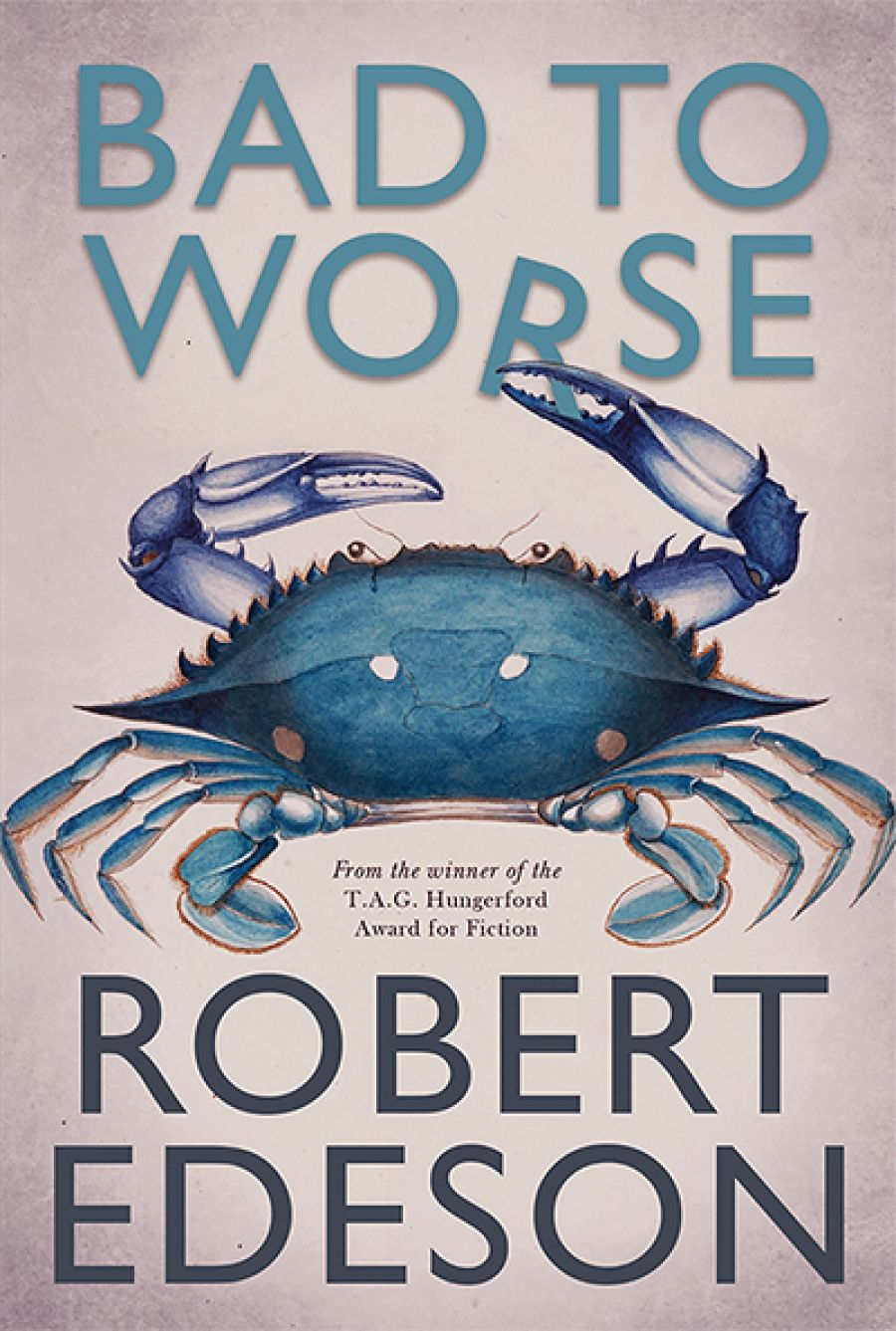
- Free Article: No
- Contents Category: Fiction
- Custom Article Title: Barry Reynolds reviews 'Bad to Worse' by Robert Edeson
- Review Article: Yes
- Online Only: No
- Custom Highlight Text:
You can’t help but smile while reading Robert Edeson’s Bad to Worse, his second book featuring Richard Worse, polymath, conversationalist, fighter, and resident of Perth. The mirth may have something to do with the Dickensian names Edeson uses throughout – not just Worse, but an aeronautics engineer called Walter Reckles, the Norwegian–British logician ...
- Book 1 Title: Bad to Worse
- Book 1 Biblio: Fremantle Press, $29.99 pb, 306 pp, 9781925164930
What violence there is is more cartoonish (not an insult) than is usually associated with the forensic gore of many mysteries and thrillers, and is quickly dealt with. Then it’s back to the smiling. As with Edeson’s previous book, The Weaver Fish (2014), the merriment starts on the title page with the far from usual acclamations from the famous, including praise from Euclid, Dante Alighieri, R. Magritte, A. Einstein – and St Ignorius. The author’s attitude to religion is probably summed up in the name.
There are a few loose strands in this book that are never resolved, probably teasers for the next in the series, which you can’t help feeling is on the horizon, not too far from the Ferendes, islands that do not appear on any map but play an important role in Worse’s journey. But then the whole book is somehow just a few degrees off true north. At some point, Edeson is going to have to explain the giant crab that walks on two legs.
The conceit in the foreword is that Magdalena Letterby, its writer, does not know the author of the book that follows, but cheekily recommends that the work be read five times in order to fully understand it. Twice will probably suffice.
The story begins in Dante, Arizona, in 1877, with the death of Rigo Mortiss at the hands of the first Worse to settle in the area. And thus is ignited a feud between the Worses and the Mortisses, who eventually expand their business interests to become a multinational conglomerate. The feud spills over into Perth, when Richard Worse and his particular range of skills are enlisted to investigate a mid-air collision involving Walter Reckles and an object that seems to have originated at a mysterious, closely guarded no-go area just outside the town of Dante, a site that seems to belong to the Worses’ arch enemies. The Mortiss family, under its present ruler, Regan Mortiss, are a particularly ruthless lot, having amassed a fortune over the generations ‘using the proven business model of forgery, extortion and murder’.
Along the way to meet a branch of the family he didn’t know existed, Worse makes a side trip to the Ferendes to help with research into the linguistics of the swint, a bird that appears to have a larger than normal brain. The swints, as with many other characters and lines of research, first made their appearance in The Weaver Fish. Edeson’s background as a consultant anaesthetist, and in neuroscience and mathematics, plays a huge part in Worse’s character, but where necessary and to move the plot, he plucks the science from the realms of his own vivid imagination.
The world’s problems are more easily fixed in Edeson’s world than ours, but that is part of the fun. There is enough that is familiar in his world to take the reader along for the ride. But, unlike Edeson’s scholarly writing, he is not above taking us on a tangent that cannot exist in our reality. History, scripture, and French philosophy are just a few topics that Edeson makes up as he goes along, negating the need for the meticulous research that necessarily goes into his other works. As Edeson has said, it also takes copyright and defamation out of the equation.
 Robert Edeson
Robert Edeson
The main narrative is interrupted and illuminated by letters, emails, footnotes, and other asides that can bring an unnecessary lull in proceedings. But these are amusing vignettes in their own right, some raising far more questions that they answer and leaving the reader wanting them to continue, yet, paradoxically, longing to get back to the action. There is even an index – often sacrificed in the name of cost cutting in some non-fiction – keeping intact the pretence of a scholar at work.
In Edeson’s universe, witty, amusing, and learned conversation still has its place in human interaction, and no non sequitur is sneered at. Worse and his sometime travel companion Sigrid Blitt’s exchanges range from observations about the logic of police officers to Dante’s Inferno being translated into limericks. Other exchanges follow similar paths.
Edeson’s writing has a rhythm all its own that is unlike other mystery stories and thrillers, and has to do with the ease and confidence with which he can take the reader from the familiar directly into a little bit of Worseworld. And it is with great glee that we often hear ourselves saying, ‘Surely he made that bit up, didn’t he? Didn’t he?’ For the most part, Edeson gives us villains who are truly awful and good guys who are either virtuous or immensely learned, with researchers willing to face any peril in the pursuit of knowledge. It all makes for a joyful ride, lots of smiles – and frequent checking of dictionaries and other references.


Comments powered by CComment